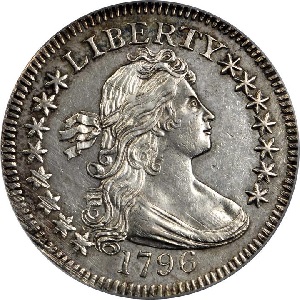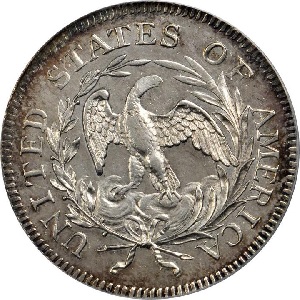1796 Draped Bust Small Eagle Quarter
Henry DeSaussure succeeded David Rittenhouse as Mint Director in July 1795. DeSaussure was on the job only three months, but during his short tenure he enlisted famed artist Gilbert Stuart to upgrade the image of United States coinage.(1)
To portray Miss Liberty, Stuart prepared a sketch modeled after an aristocratic Philadelphia woman named Ann Willing Bingham. Stuart’s work was transferred to coinage, appearing first on the silver dollar in late 1795, and became what numismatists refer to as the Draped Bust design.(2)
Stuart was displeased with the coin results and disavowed any involvement in their development. It wasn’t until 1861 that the Mint confirmed Stuart’s role, 33 years after his death!(3)
The 1796 Draped Bust quarter was the first of its denomination to hit the streets of America. Of the five silver coin face values specified in the Mint Act of 1792, the quarter was the last to debut.
Only 6,146 pieces dated 1796 were struck before quarter production was stopped, not to resume until 1804, at which time the Mint retained the Draped Bust obverse but switched to a larger eagle on the reverse.(4)
The 1796 Draped Bust quarter ranks as one of the most important coins from the early United States and has been eagerly pursued by collectors for ages. Let’s list the reasons why this is such a great coin:(5)
- It has a very small mintage.
- It is the first quarter released by the United States.
- It is a one-year only type coin.
- It is the only U.S. quarter from the 18th century.
Why was there so few 1796 quarters made? Why were quarters not struck again until 1804? The answers can be traced back to colonial times.
For centuries, Spanish coins circulated in the Americas. The primary Spanish silver coin, the Eight Reales – also called the “Piece of Eight” -- was ubiquitous. (The Eight Reales served as the model for the U.S. silver dollar in terms of size and silver content)(6)
The Piece of Eight coin was frequently cut into 1/8, 1/4, and 1/2 bits to facilitate smaller business transactions. The real (pronounced as "ree all") was often known as a “bit.” Two reales, also called "two bits" in American vernacular, contained about 25 cents worth of silver and circulated readily alongside the Eight Reales.(7)
When the United States began minting the quarter dollar in 1796, the idea was that it would replace the Spanish two bits. Faced with perennial budgetary constraints, the fledgling Mint decided that since the two bits already circulated in appreciable quantities, it would be unwise to spend scarce resources to make additional 25 cent coins. Consequently, no more quarters were issued by the United States until 1804.(8)
The Mint employed two obverse dies paired with one reverse to strike the entire mintage of 1796 quarters. The Browning-1 (B-1 for short) die variety features a lower 6 in the date. A higher 6 is present on the B-2, and of the two varieties is the one seen most frequently.(9)
There really aren’t many coins with a more impressive resumé in the entire United States series than the 1796 Draped Bust quarter. Thankfully, it has a high survivorship rate of about 10%,(10) but even at that, there is nowhere enough supply to meet the crunching demand for this landmark relic from the formative years of the United States Mint.
| Estimated survivors in all grades: 650 ?
The survivor estimate from PCGS represents an average of one or more experts' opinions as to how many examples survive of a particular coin in all grades. Survival estimates include coins that are raw, certified by PCGS, and certified by other grading services. Learn more at PCGS. |
| PCGS Rarity Scale: 5.7 ?
The 'PCGS CoinFacts Rarity Scale' assesses the relative rarity of all U.S. coins, based on estimated surviving examples. The scale runs from 1.0 to 10.0. The higher the number, the rarer the coin.
Learn more at PCGS. |
| Click HERE to check for availability on eBay** |
Preview of eBay selection:
 |
 |
| Trendline Avg = 9.86 | CLASSIC RARITY |
Historic Value Trend Charts:
| Last updated 4-8-25 | Return to Key Date Coin List | |
| There are no Common Date comparisons for this coin. | ||
|
|
||
| Download Charts to Your Computer | ||
Sources
1. Taxay, Don. The U.S. Mint and Coinage. New York, NY: Sanford J. Durst Numismatic Publications, 1966.
2. NGC. Early Quarters (1796-1838).
3. Stack's Bowers Galleries. 1795 Draped Bust Silver Dollar. May 2016 Auction.
4. Yeoman, R.S. and Garrett, Jeff, et al. A Guide Book of United States Coins, 75th ed. Pelham, AL: Whitman Publishing, 2021.
5. Garrett, Jeff and Guth, Ron. 100 Greatest U.S. Coins, 5th ed. Pelham, AL: Whitman Publishing, 2019.
6. Yeoman, R.S. and Garrett, Jeff, et al. A Guide Book of United States Coins, 75th ed. Pelham, AL: Whitman Publishing, 2021.
7. Bowers, Q. David. The History of United States Coinage. Los Angeles, CA: Bowers and Ruddy Galleries, Inc., 1979.
8. Doty, Richard. America's Money, America's Story. Iola, WI: Krause Publications, 1998.
9. Stack's Bowers Galleries. 1796 Draped Bust Quarter. B-2.
10. PCGS. 1796 25C (Regular Strike).
**Many very fine coin dealers sell on eBay. At any point in time, there may be over one million search results for United States coins. This includes quite a few of the recommendations on our Key Date Coin List.
If you’re thinking about purchasing a rare coin, eBay is certainly worth a look. For your convenience, the links from this site to eBay are coded to bring up only coins certified by PCGS and NGC.
As is always, always the case, never buy a valuable coin from a seller whose trustworthiness cannot be verified. Learn more about this at our chapter Best Places to Buy Coins, which also has a section on doing business on eBay.
In the interest of full disclosure, Rare Coins 101 receives a small commission anytime someone connects to eBay from this site and purchases something.
Coin images by Stack's Bowers Galleries.


